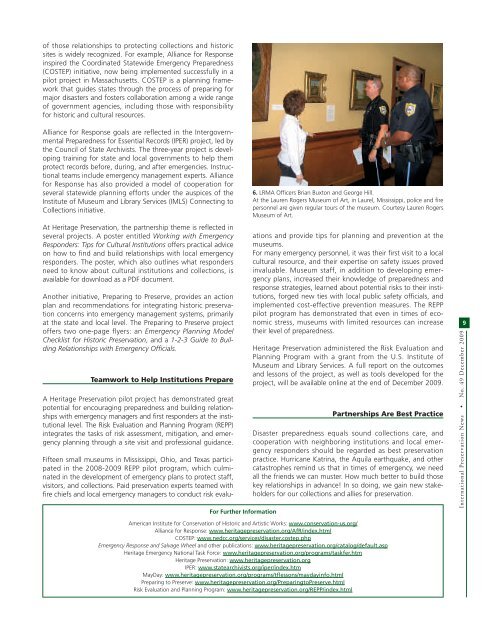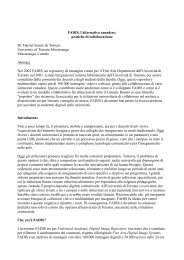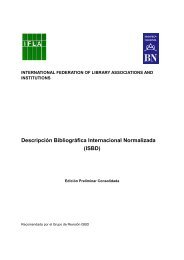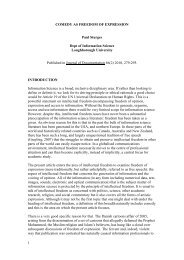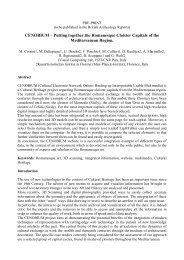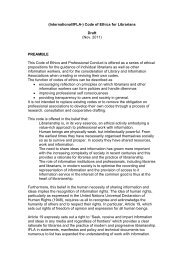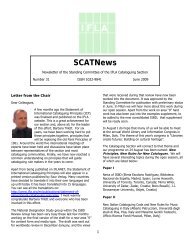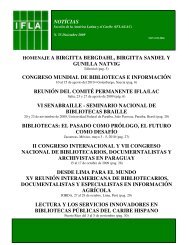No 49 - IFLA
No 49 - IFLA
No 49 - IFLA
You also want an ePaper? Increase the reach of your titles
YUMPU automatically turns print PDFs into web optimized ePapers that Google loves.
of those relationships to protecting collections and historic<br />
sites is widely recognized. For example, Alliance for Response<br />
inspired the Coordinated Statewide Emergency Preparedness<br />
(COSTEP) initiative, now being implemented successfully in a<br />
pilot project in Massachusetts. COSTEP is a planning framework<br />
that guides states through the process of preparing for<br />
major disasters and fosters collaboration among a wide range<br />
of government agencies, including those with responsibility<br />
for historic and cultural resources.<br />
Alliance for Response goals are reflected in the Intergovernmental<br />
Preparedness for Essential Records (IPER) project, led by<br />
the Council of State Archivists. The three-year project is developing<br />
training for state and local governments to help them<br />
protect records before, during, and after emergencies. Instructional<br />
teams include emergency management experts. Alliance<br />
for Response has also provided a model of cooperation for<br />
several statewide planning efforts under the auspices of the<br />
Institute of Museum and Library Services (IMLS) Connecting to<br />
Collections initiative.<br />
At Heritage Preservation, the partnership theme is reflected in<br />
several projects. A poster entitled Working with Emergency<br />
Responders: Tips for Cultural Institutions offers practical advice<br />
on how to find and build relationships with local emergency<br />
responders. The poster, which also outlines what responders<br />
need to know about cultural institutions and collections, is<br />
available for download as a PDF document.<br />
Another initiative, Preparing to Preserve, provides an action<br />
plan and recommendations for integrating historic preservation<br />
concerns into emergency management systems, primarily<br />
at the state and local level. The Preparing to Preserve project<br />
offers two one-page flyers: an Emergency Planning Model<br />
Checklist for Historic Preservation, and a 1-2-3 Guide to Building<br />
Relationships with Emergency Officials.<br />
Teamwork to Help Institutions Prepare<br />
A Heritage Preservation pilot project has demonstrated great<br />
potential for encouraging preparedness and building relationships<br />
with emergency managers and first responders at the institutional<br />
level. The Risk Evaluation and Planning Program (REPP)<br />
integrates the tasks of risk assessment, mitigation, and emergency<br />
planning through a site visit and professional guidance.<br />
Fifteen small museums in Mississippi, Ohio, and Texas participated<br />
in the 2008-2009 REPP pilot program, which culminated<br />
in the development of emergency plans to protect staff,<br />
visitors, and collections. Paid preservation experts teamed with<br />
fire chiefs and local emergency managers to conduct risk evalu-<br />
For Further Information<br />
6. LRMA Officers Brian Buxton and George Hill.<br />
At the Lauren Rogers Museum of Art, in Laurel, Mississippi, police and fire<br />
personnel are given regular tours of the museum. Courtesy Lauren Rogers<br />
Museum of Art.<br />
ations and provide tips for planning and prevention at the<br />
museums.<br />
For many emergency personnel, it was their first visit to a local<br />
cultural resource, and their expertise on safety issues proved<br />
invaluable. Museum staff, in addition to developing emergency<br />
plans, increased their knowledge of preparedness and<br />
response strategies, learned about potential risks to their institutions,<br />
forged new ties with local public safety officials, and<br />
implemented cost-effective prevention measures. The REPP<br />
pilot program has demonstrated that even in times of economic<br />
stress, museums with limited resources can increase<br />
their level of preparedness.<br />
Heritage Preservation administered the Risk Evaluation and<br />
Planning Program with a grant from the U.S. Institute of<br />
Museum and Library Services. A full report on the outcomes<br />
and lessons of the project, as well as tools developed for the<br />
project, will be available online at the end of December 2009.<br />
Partnerships Are Best Practice<br />
Disaster preparedness equals sound collections care, and<br />
cooperation with neighboring institutions and local emergency<br />
responders should be regarded as best preservation<br />
practice. Hurricane Katrina, the Aquila earthquake, and other<br />
catastrophes remind us that in times of emergency, we need<br />
all the friends we can muster. How much better to build those<br />
key relationships in advance! In so doing, we gain new stakeholders<br />
for our collections and allies for preservation.<br />
American Institute for Conservation of Historic and Artistic Works: www.conservation-us.org/<br />
Alliance for Response: www.heritagepreservation.org/AfR/index.html<br />
COSTEP: www.nedcc.org/services/disaster.costep.php<br />
Emergency Response and Salvage Wheel and other publications: www.heritagepreservation.org/catalog/default.asp<br />
Heritage Emergency National Task Force: www.heritagepreservation.org/programs/taskfer.htm<br />
Heritage Preservation: www.heritagepreservation.org<br />
IPER: www.statearchivists.org/iper/index.htm<br />
MayDay: www.heritagepreservation.org/programs/tflessons/maydayinfo.html<br />
Preparing to Preserve: www.heritagepreservation.org/PreparingtoPreserve.html<br />
Risk Evaluation and Planning Program: www.heritagepreservation.org/REPP/index.html<br />
9<br />
International Preservation News <strong>No</strong>. <strong>49</strong> December 2009


